The Independent Center for Integrative Education: Learning without Limits
01/25/2011
Today, the biologists of Atlantis-2 presented their achievements in genetical engineering of animals and plants for our colony. Please read the summary below and the homework assignment at the bottom.
Our first presenter was Adina. She presented the Amazing Mini Meat Tree, a new concept in growing food and a marvel of genetic engineering. The Tree is a result of mixing the genes of a cow, a Japanese Maple tree, and a special proprietary gene created in the laboratory from scratch. Basically, it is a cow without a brain and with leaves for photosynthesis. The latest modification has also some coral genes and can grow in low light. The tree produces meat that can be used as any other meat but a) without keeping animals and b) without killing any animals. Regretfully, many cows had to be killed during the research stage. The Tree is available in three flavors: beef, pork, and a fish bush. The latter is for export because we have more than enough fish flavor in Atlantis-2. At this stage of research, the Amazing Mini Meat Tree cannot reproduce and is therefore quite expensive.
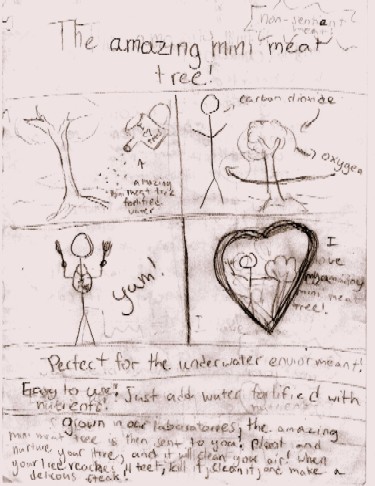
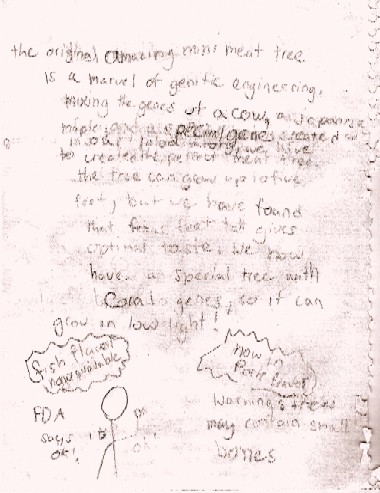
Then Caoilin presented her invention that she called the Giant Rafflesia Pad or GRP for short - huge plants with lilipads of the size of 3 ft. in diameter, which she obtained by genetically modifying the Giant Rafflesia, the largest and the smelliest flower in the world (which scientifically is not exactly a flower, see http://en.wikipedia.org/wiki/Rafflesia) and mixing it with the Lilypad. The resulting plant could grow with its roots at the sea floor and its huge leaves inside the living domes where they would absorb natural and artificial light and consume carbon dioxide emitting oxygen and fresh water. So far, no solution was found to reduce the smell. Therefore, special ventillators and filters will be needed. The plant will be also used as decoration. It is rather expensive, but with its reproductive powers, you should only buy one plant to have as many as you need.
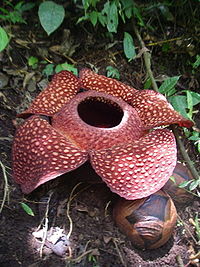 +
+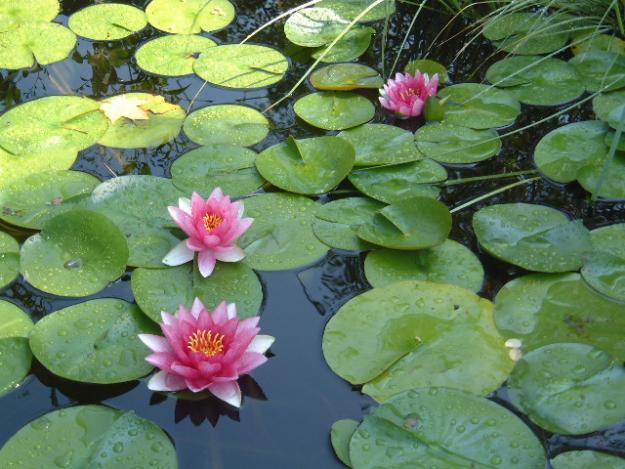 =
=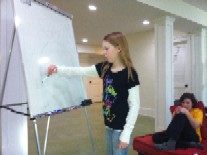
Dan presented five different animals developed for different purposes.

- Goat-ee, that can clean parasites from the outside of the dome. The genetical recipe of this animal is currently secret but the rumors have it that he mixed the genes of a goat and a manatee.
- WhalePhant, that apparently is a mix of the genes of a whale and an elephant. WhalePhants will be usefol in moving big things. The animals are smart and can use their trunks as tubas to play music.
- Peli-Fish is bigger than both of its components. It is not just a hybrid of a fish and a pelican. A specially engineered secret gene was also added to make the animal smart. The creature can swim to the surface and then fly as a bird. The creature is trainable like pigeons and is intended to carry mail and other things.
- Potato-rilla is a most amazing genetically engineered organism because it combines traits from the stupidest of plants and of a highly advanced animal, namely a potato and a gorilla. It is the size of a gorilla and, combining feeding abilities of both plants and animals, does not require any care. Potato-rillas are mobile but have roots and may attach to the ground when they need minerals that are not dissolved in sea water. They also filter plankton. From potatos, they inherited multiple eyes and can see in all directions simultaneously. They don't live long and, when they die, are quite edible.
- Last but not least, Salmo-Chicken is a great source of food, both meat and eggs. It lives outside the dome and eats waste, plants, plankton and fish.
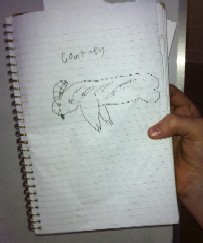
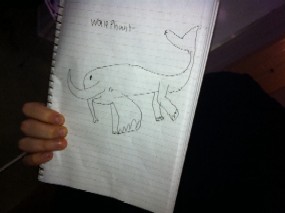
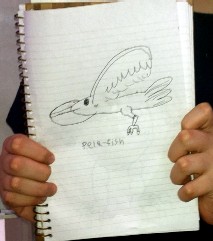
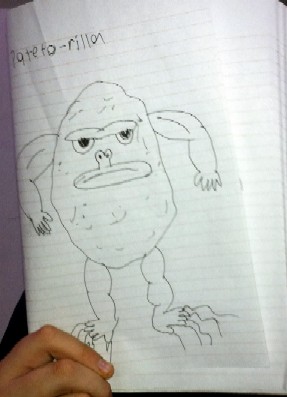
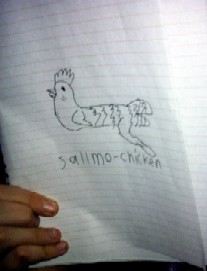
Eugene presented his latest invention, Kangaroofish. He used genes from a kangaroo and a mermaid, so there is nothing fishy about it. The combination allowed converting the kangaroo's jumping power into a powerful propelling force, and the animal is mainly intended as a means of transportation akin to horses on land. The animals are scavengers and eat remains of dead fish and other sea creatures. The gestation period takes three month and a newborn spends fifteen month in the mother's pouch. There is usually one pup, rarely two.

.
John's invention is unusual by its universality. He found a way to add seaweed genes to any plant, including tomatos and strawberries. The fruits do not change their taste and flavor but can survive under water with less sunlight, collecting oxygen and carbon dioxide dissolved in water. In addition, using genes from sponges, they can filter plankton for food. The plants can be grown by gardeners - SCUBA divers riding kangaroofish. Zach kindly helped John with the artistic part of the presentation.
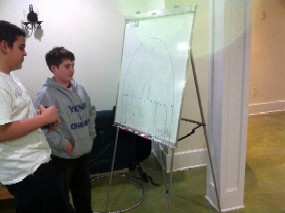
Zach promised to present his inventions in our next class because he forgot to bring his drawings.
And then we had a break and Doctor was our guest again.

After the break, we talked about the psychological issues that Atlantis-2 may face. We discussed information and experience obtained from space station work, Mars expedition research, and polar expeditions. We learned that animals in high-density accommodations become aggressive and highly territorial, and so do people. The famous polar explorer Admiral Richard Byrd described living conditions at Little America, the Antarctic scientific research station: "Arguments clung to us always. They started innocently, gathered increasing strength and became so fraught with passion as to threaten to bring down the roof. They seemed to have no end."
High density is a physical condition, and crowdedness is a subjective psychological condition. For example, the crush of people in the lobby of a theater during intermission of a popular play may not be experienced as crowding despite the extremely high population density. At the same time, people feel crowded when they live in a small town when everybody knows everything about every one and put their noses in other people affairs.
Studies of long-term isolation in Antarctica and a simulated Mars base in Canada show that a mixture of male and female crew members help alleviate conflicts. When out of touch with women, men tended to neglect their appearance and put a hardened shell on their feelings that leads to more serious conflicts down the road.
Thor Heyerdahl, the great Norwegian adventurer of Kon Tiki expedition fame, floated several oceans on primitive rafts to prove his native migration theories. He described psychological issues with people who "have to rub shoulders for weeks" as "mental sickness, which may be called 'expedition fever' - a psychological condition that makes even the most peaceful person irritable, angry, furious, absolutely desperate, because his perceptive capacity gradually shrinks until he sees only his companions faults, while their good qualities are no longer recorded in his gray matter."
Of utmost importance to the success of any expedition were the qualities of the leader. Given a charismatic, fair and respected leader, people would pull together and overcome minor differences, instead of letting small problems snowball into crises.
Even though researchers (for obvious reasons) focus mainly on prevention of problems, there are some psychological benefits of closesness. Some data on the psychology of small towns show that people develop important positive feeling of belonging to a community and learn to appreciate diversity in others and themselves. When people know much about each other, they may rely on others to get help even without asking when they need something or are in trouble in some way. There is a sense of needing to look after each other. People can interact with each other without too much concern about whether they fit or not. Everyone belongs, just by virtue of living there.
We identified the following factors that may cause psychological problems:
- Isolation from the outside world for long periods of time
- Crowdedness
- Stress and danger, traumatic experiences
- Monotonous environment, lack of stimulation
- Limited entertainment and recreational facilities
- Lack of sunlight
- Noises, vibration of machinery
- Loneliness, boredom
- Winter blues, or Seasonal affective disorder (SAD)
- Interpersonal frictions
- Rivalry and jelousy
- Politics (cliques, careerism, privileges)
- Frequent divorces
- Depressions, burnouts, debilitating conditions, psychosomatic disorders
- Social withdrawal
- Phobias (claustrophobia), post-traumatic stress disorder
- Self-medication with drugs, alcohol, binge eating, and risky behavior
- Careful people selection
- Psychological education and training on how to talk to people without aggravating them
- Self-diagnostic training
- Counseling
- Psychotherapy - a must for everybody
- Religion for the believers
- Frequent brief vacations
- Rotation of responsibilities
- Right male-female proportion and a right number of married couples
- Efficient motivation (money not an issue, interest and enthusiasm, 80/20 etc.)
- Hobbies supported and encouraged, including financial help
- Tactful psychological monitoring
- Respected and charismatic leader
- Entertainment
- Individual space including separate rooms for everybody
- Artificial sunlight
- The happy room with bright colors everywhere
Here are links to some sources I read in preparation for the class that you might find interesting:
Isolation in Historical Cases and the Implications for a Mars Mission by Eben Sargent, 2002
Psychology and Space Travel: Planning for a Mars Mission by Anna Nicholson-Hutt, 2004
The Psychology of Space Flight, David Levin interviews Al Holand, December 2010
The Psychology of Small Towns by Helen Smit, October 7, 2009.
Angles of Applied Psychology, by J. Russel, M. Jarvis, C. Roberts, D. Dwyer,and D. Putwain, 2003, p. 357
The Biology and Psychology of Crowding in Man and Animals by C.H. Southwick, The Ohio Journal of Science, 1971, Vol. 71, No. 2, p. 65
Chilean Miners and Psychology of Confinement by Tanya Debi, November 2010
All of us will become leaders at some point in our lives, be it in family, at work, or among friends. To prepare for that time, we may start with imagining how each of us would behave as a leader in a time of crisis.
Please imagine that you are our leader. Think of a crisis situation that involves some of the psychological issues listed above. Make up a plan to resolve the situation and describe in as much detail as possible the events unfold.. In the next class, tell us the story. You may read to us from your made-up diary or write a script so that we can role play the overcoming of the crisis under your command. This are just suggestions, you may make up another format for your presentation.
As always, homework is optional but very much recommended.
Dear parents, I would highly encourage you to help you children with this assignment.
I look forward to seeing you all on Tuesday.
-Valéry
.